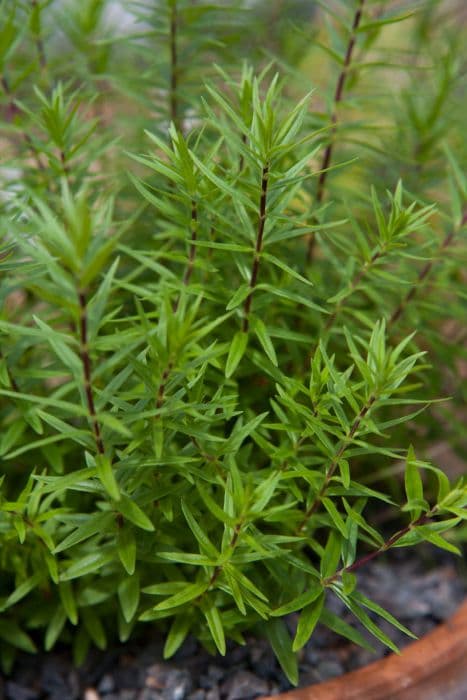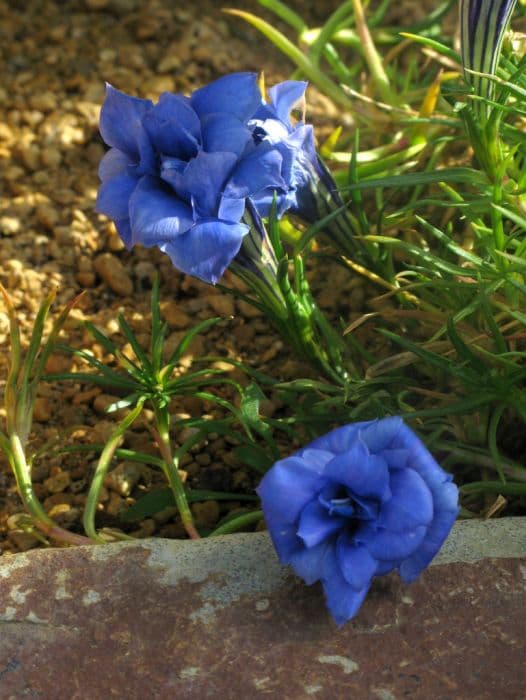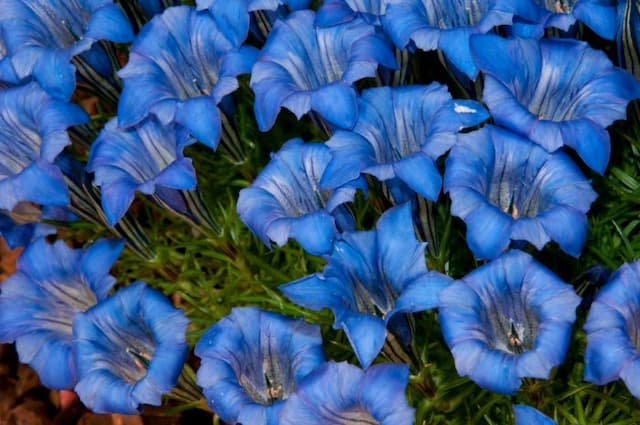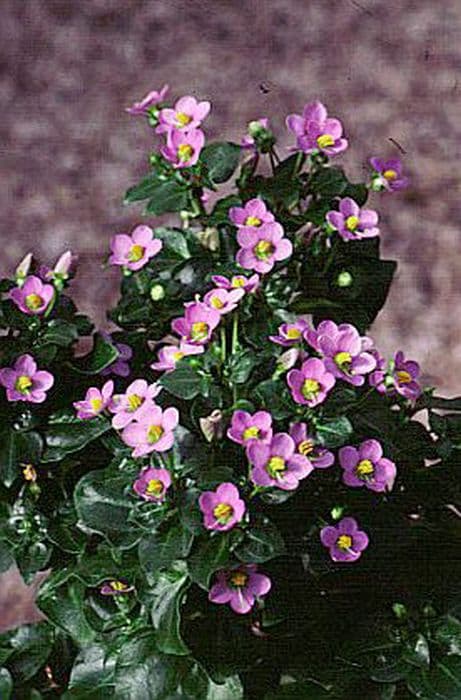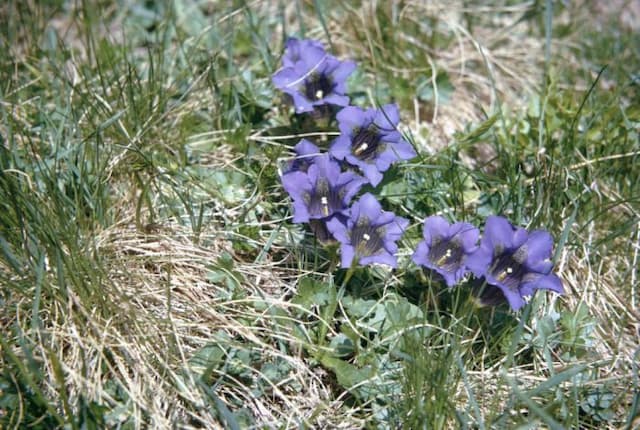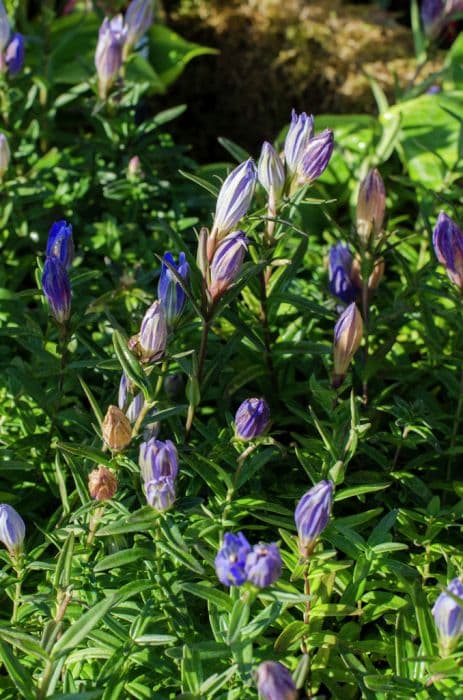Steven's Gentian Gentiana × stevenagensis

ABOUT
Gentiana × stevenagensis, also known as the garden gentian, is a perennial plant that boasts an impressive display of vibrant flowers. The plant flowers extensively, showcasing a bold, deep blue or sometimes violet coloration which captures the eye. These trumpet-shaped flowers are a key characteristic of the plant, clustered atop the stems and commanding attention with their vivid hues. The garden gentian's leaves are simple yet elegant, arranged in a basal rosette. They display a glossy green color, often lance-shaped or ovate, providing a lush backdrop to the striking flowers. The foliage's lushness adds to the overall aesthetic appeal of the plant, creating a harmonious blend of color and form. Overall, the appearance of the garden gentian is one of robust beauty, with its intense blue flowers standing out against the verdant foliage. This plant adds a splash of cool-toned color to gardens, making it a sought-after choice for gardeners looking to create a visually arresting display in their outdoor spaces.
About this plant
 Names
NamesFamily
Gentianaceae
Synonyms
Steven's Gentian
Common names
Gentiana × stevenagensis
 Toxicity
ToxicityTo humans
Gentiana × stevenagensis, commonly referred to as the Bigelow's gentian, does not have a well-documented profile of toxicity to humans. Generally, gentians are not known for being toxic to humans. However, as with any plant, individuals may have allergies or sensitivities. Ingesting any plant that is not typically used for consumption can potentially cause gastrointestinal upset or allergic reactions in some people. As there is limited information on the specific hybrid Gentiana × stevenagensis and its effects when ingested by humans, it is advisable to exercise caution and keep it out of the reach of children who might inadvertently ingest it.
To pets
Gentiana × stevenagensis, known as Bigelow's gentian, is not widely reported to be toxic to pets. The gentian family is not commonly associated with toxicity in animals. That being said, individual animals might experience mild gastrointestinal upset if they consume parts of the plant. As always, it's prudent to prevent pets from ingesting plants that are not meant for consumption. If a pet does consume part of a Bigelow's gentian and exhibits any signs of distress such as vomiting, diarrhea, or unusual behavior, it is advised to consult a veterinarian.
 Characteristics
CharacteristicsLife cycle
Perennials
Foliage type
Deciduous
Color of leaves
Green
Flower color
Blue
Height
1-2 feet (30-60 cm)
Spread
1 foot (30 cm)
Plant type
Herb
Hardiness zones
Varies
Native area
Hybrid
Benefits
 General Benefits
General Benefits- Aesthetic Appeal: Adds vibrant blue to purple flowers to gardens and landscapes, creating visual interest and enhancing the overall beauty of the space.
- Diversity in Gardening: Offers an option for gardeners looking to introduce variety into their plantings with a less common species.
- Attracts Pollinators: Provides nectar for pollinators such as bees and butterflies, promoting biodiversity and contributing to the health of the local ecosystem.
- Low Maintenance: Typically requires minimal care once established, making it a suitable choice for gardeners of all skill levels.
- Cold Tolerance: Possesses the ability to withstand cooler temperatures, which can be beneficial in temperate climate zones.
- Longevity: Known to have a relatively long bloom period, extending the time gardeners and onlookers can enjoy its flowers.
- Adaptability: Can grow in a variety of soil types, as long as they are well-draining, offering flexibility in garden design and placement.
 Medical Properties
Medical PropertiesThis plant is not used for medical purposes.
 Air-purifying Qualities
Air-purifying QualitiesThis plant is not specifically known for air purifying qualities.
 Other Uses
Other Uses- Gentiana × stevenagensis can be used as a natural dye for fabrics, producing a range of blue and green hues depending on the mordant used.
- The roots of the plant can be incorporated into compost as a biomass that enriches the soil with organic matter.
- In floral photography, the vivid colors of the Gentiana × stevenagensis make it an excellent subject for macro photography, showcasing the detailed structure of its flowers.
- This plant can serve as an educational tool in botany studies, demonstrating hybrid vigor and the process of hybridization.
- As part of eco-friendly landscaping, the Gentiana × stevenagensis can be used to create sustainable garden designs that require minimal maintenance and water.
- Gentiana × stevenagensis can be planted to help stabilize soil in areas prone to erosion due to its root system that holds the soil together.
- Its distinctive blooms can also be utilized in artistic arrangements, such as the Japanese art of Ikebana, to give a unique aesthetic to the compositions.
- The plant can be cultivated as part of butterfly gardens to attract butterflies and support pollinator biodiversity.
- In colder regions, Gentiana × stevenagensis can be grown in alpine rock gardens, mimicking its natural habitat and contributing to alpine plant conservation efforts.
- The plant can be used in sensory gardens, where its vibrant colors and textures provide a stimulating and therapeutic environment for visitors with special needs.
Interesting Facts
 Feng Shui
Feng ShuiThe plant Gentiana × stevenagensis, commonly known as Steven's gentian, is not used in Feng Shui practice.
 Zodiac Sign Compitability
Zodiac Sign CompitabilitySteven's gentian is not used in astrology practice.
 Plant Symbolism
Plant Symbolism- Persistence: Gentiana × stevenagensis, commonly known as Gentian, often symbolizes persistence due to its ability to thrive in difficult growing conditions and rocky terrains.
- Victory after Struggle: The plant's ability to bloom in harsh environments gives it a symbolic association with achieving success after overcoming significant challenges.
- Intrinsic Worth: Gentian is sometimes considered a symbol of intrinsic value, reflecting the idea that true worth comes from within and not from external appearances.
 Water
WaterThe Showy Gentian should be watered deeply, ensuring the soil is evenly moist but never soggy. During the growing season, water the plant approximately once a week with about one gallon of water per session, depending on the weather conditions and soil drainage. During the winter, reduce watering to every other week or less, monitoring soil moisture before adding more water. Always avoid letting the soil dry out completely, as this can stress the plant.
 Light
LightShowy Gentian thrives best in full sunlight to partial shade. It prefers a spot that receives several hours of direct sunlight each day, but it can also tolerate a location that offers dappled sunlight, especially during the hottest part of the day. Avoid placing it in deep shade, as this can impede its growth and flower production.
 Temperature
TemperatureShowy Gentian prefers moderate temperatures and can generally withstand temperatures as low as 20°F and as high as 75°F. Ideal growing conditions for this plant are between 50°F and 65°F. It is important to protect the plant from frost, which can damage its leaves and stems.
 Pruning
PruningShowy Gentian benefits from light pruning to remove dead or faded flowers, which encourages additional blooming. Prune just above a leaf node after the first flowering period to promote a second wave of blooms. The best time for pruning is immediately after the flowers fade, which is typically late summer or early fall.
 Cleaning
CleaningAs needed
 Soil
SoilThe best soil mix for Gentiana (more commonly known as Gentian) should be well-draining yet moist, comprising a mixture of loamy soil, peat, and sand. It thrives in a slightly acidic to neutral pH, ranging from 5.5 to 7.0, to support its growth and flowering requirements.
 Repotting
RepottingGentian does not generally require frequent repotting; it can be done every 2-3 years or when you notice that the plant has outgrown its current pot. Spring is the best time to repot to minimize stress on the plant.
 Humidity & Misting
Humidity & MistingGentian prefers moderate humidity levels but is quite adaptable. To maintain optimal growth, aim for a humidity level of around 40-50%. Keep the plant away from dry, drafty areas to ensure it thrives.
 Suitable locations
Suitable locationsIndoor
Ensure bright, indirect light and keep soil consistently moist.
Outdoor
Plant in part shade, provide moist soil and shelter from harsh sun.
Hardiness zone
3-8 USDA
 Life cycle
Life cycleThe life of Gentianella x stevenagensis, also known as Gentiana x stevenagensis or more commonly, the Big Ben gentian, begins with seed germination in spring, where the seeds require a period of cold stratification to break dormancy. Upon germination, seedlings develop a small rosette of basal leaves and a root system. In the following growth season, the plant develops a flowering stem and blooms with characteristic blue trumpet-shaped flowers, typically in late summer to early autumn. After pollination by insects attracted to the flowers' bright colors and nectar, seeds are produced and dispersed by wind or gravity. As a perennial, the plant will regrow from its rootstock the following spring, continuing this cycle for several years. In harsh conditions, the plant may remain in a vegetative state for a season, delaying flowering until more favorable conditions arise.
 Propogation
PropogationPropogation time
Spring to summer
Propogation: The most common method of propagating Gentiana × stevenagensis, also known as hybrid gentian, is by seed. Sowing seeds directly into a well-draining soil mix during spring after the last frost can yield good results. The seeds should be superficially scattered onto the soil surface and lightly covered with a thin layer of soil, as they require light for germination. Gentle watering should be conducted to keep the soil moist but not waterlogged. Germination can be slow and erratic, often taking anywhere from several weeks to a few months. It's essential to keep the seedlings protected from extreme temperatures and strong direct sunlight until they are robust enough to be transplanted to their final location.

